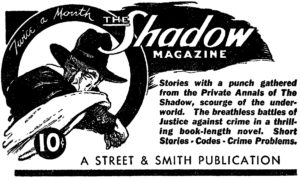
Ads and promotions for The Shadow appeared in many forms. Below you will see examples of some of them. Most are advertisements intended to entice radio listeners to tune in each Sunday afternoon for another exciting episode of The Shadow program. There are also a few advertisements for the pulp magazines and movies shown.
Ink blotters were probably the most commonly found types of advertising material for The Shadow. Although nobody uses ink blotters any more, back in the old radio era ball-point pens were not yet being mass produced and most people wrote with fountain pens and regularly used ink blotters. They were cheap to produce and became a popular advertising medium for all sorts of products and businesses.
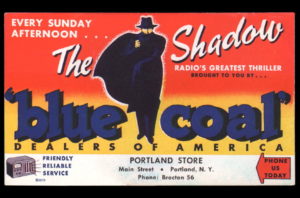
Ink blotters
Usually, the ink blotters found that promoted The Shadow were primarily advertising the sponsor’s product, Blue Coal. But in a corner, there was often a small ad for the radio program as well.
Newspaper ads, unlike ink blotters, usually were primarily advertising for the radio show, with a brief mention of the sponsor. Such ads were often relatively small and found near the section of the newspaper with the radio schedules.
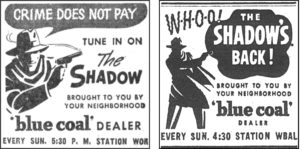
Other pulp magazines carried ads for The Shadow — usually Street & Smith publications, since they owned The Shadow. In The Shadow Magazine, the editors would occasionally run ads for the radio show, as space permitted. Often these ads would appear at the beginning of the radio season to help listeners establish a regular listening pattern.
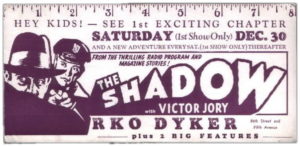
On Jan. 5, 1940, Columbia Pictures released a 15-chapter serial, The Shadow. It was mostly patterned after the pulp version of The Shadow, but had many elements of the radio Shadow incorporated into it as well. One of the ways they promoted the film was to hand out free ink blotters, with the theater schedule printed on it.
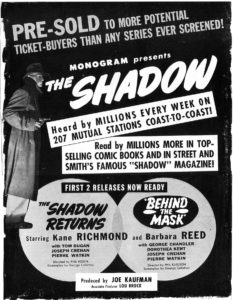
There were several series of theatrical motion pictures featuring The Shadow. The first was a series of six short features in 1931 and 1932. This was followed by two feature-length motion pictures in 1937 and 1938, both starring Rod LaRocque as The Shadow. Then came the 1940 serial with Victor Jory in the leading role. In 1946, Kane Richmond assumed the role for three more features.
Matchbooks were a distinctive method of advertising. As with ink blotters, they were inexpensive to produce, making them ideal for promotional purposes. The book of matches was unusually fancy, in that it had a pop-up of The Shadow holding a scroll, and the paper matches themselves were printed. Most matchbooks were just a printed wrap-around cover for a plain set of matches.
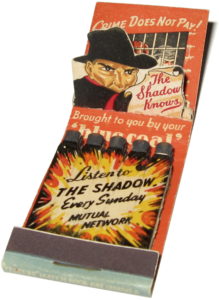
The Shadow rings
One of the most unique ways of promoting The Shadow was by utilizing mail-away premiums. Unfortunately this method was only used twice, once in 1941 and again in 1947. Both times the radio program offered a glow-in-the-dark ring to kids who would send in a nickel or dime.
The 1941 version cost a dime and featured a blue lump of plastic “coal” on top; embossed upon the sides of the band were figures of a cloaked Shadow with drawn gun. That’s somewhat ironic since it was the pulp version of The Shadow that was known for his cloak and .45 automatics, not the radio version. This ring is known among collectors as the “Blue Coal Ring.”
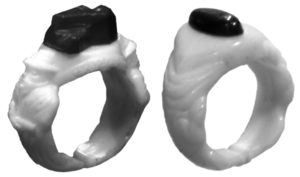
The 1947 ring is often called the “Carey Salt Ring” because it was offered by the west coast sponsor, Carey Salt. It cost a nickel and the white star from a package of Carey Salt. When producing the ring, the company was on a budget, so it reused the ring molds from an earlier radio premium made for Jack Armstrong.
The Jack Armstrong “Dragon’s Eye Ring” was offered on that show in 1940 and featured a green center stone on a band with embossed crocodiles holding the stone in their open mouths. In 1944, the same ring was offered on the Buck Rogers radio show, but the color of the stone was changed from green to red. This was called the “Buck Rogers Ring of Saturn.”
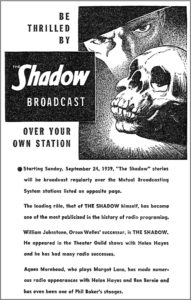
Then in 1947, Carey Salt changed the color of the center stone one more time, this time to black. Youngsters getting the 1947 version may have wondered why the band of the ring held two crocodiles with open mouths, something which had nothing to do with The Shadow. But if they had also sent away for the Jack Armstrong ring seven years previously, they would have understood.
The two rings were the only mail-away premiums ever offered by The Shadow on the radio. It does seem strange, since so many other radio programs offered recipe books, distance finders, all variety of rings, photo albums, decoders, pins, badges, movie viewers, telescopes, belts, compasses, whistles, and so, so many other wonderful things to attract and hold listeners. Perhaps the reason lay in the fact that The Shadow was not considered a kid’s show, and those were the types of shows that offered the most mail-away premiums.
Only scratching the surface…
The advertising samples described above are not the only ways that The Shadow’s radio broadcasts were advertised. But they serve as some interesting examples of what radio listeners of the 1930s and 1940s saw that promoted their favorite crimefighter, The Shadow.
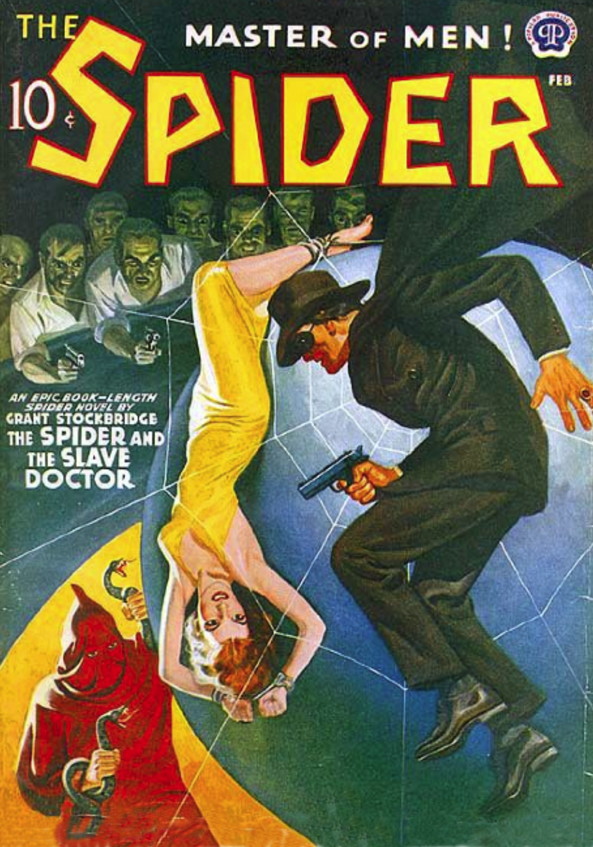
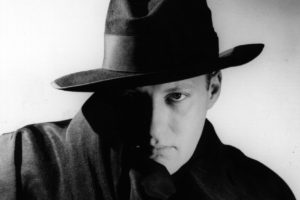
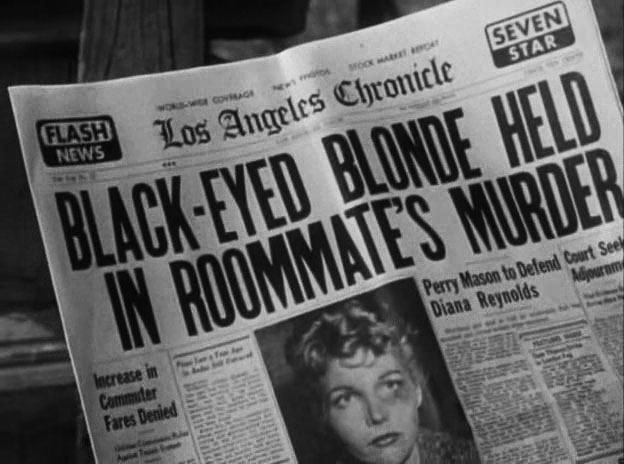
The matchbook covers are new to me, pretty cool!
I found the matchbook on eBay about ten years ago. I had seen pictures before that, and always wanted one. And I haven’t seen one for sale since. I was lucky to find one with all the matches still intact. The pop-up Shadow is pretty unique.
That pop-up Shadow matchbook you own is indeed unique. I can’t think offhand of another matchbook so designed. I’ll bet James Lileks, who shows his great collection of matchbooks on his website, doesn’t have one remotely like yours!
I hear that there are matchbook collectors out there, but it’s an area which I know almost nothing about. I remember hearing that collectors generally don’t want the matches included. Maybe a fire danger? So, they just collect the matchbook cover alone. I’m glad that mine includes the matches because part of the Shadow ad is actually printed on the paper matches.
As for the extra little pop-up of The Shadow, I’ve never seen that type of thing on any other matchbook. Again, I’m no expert, so that probably doesn’t mean much. It would be interesting for a matchbook collector to weigh in here, and clear up how unusual the pop-up feature is. And do collectors prefer to have the actual matches included, or not? Inquiring minds want to know.